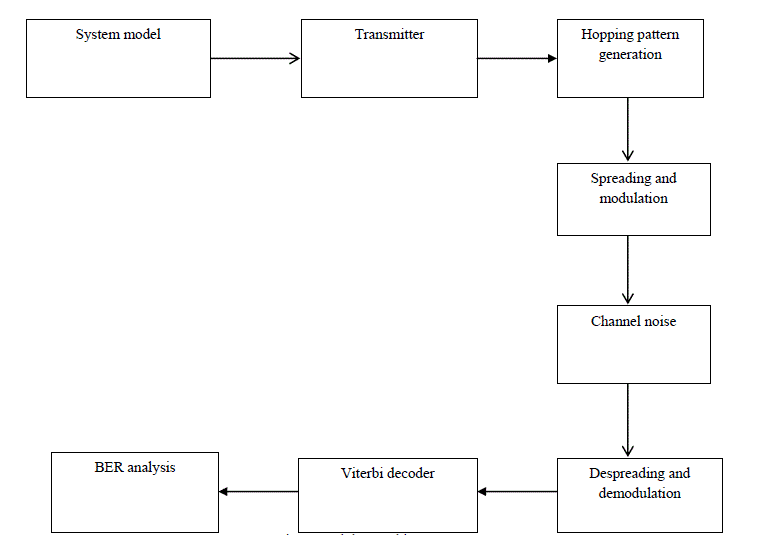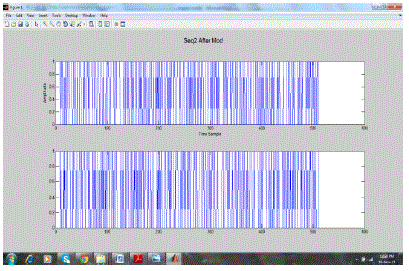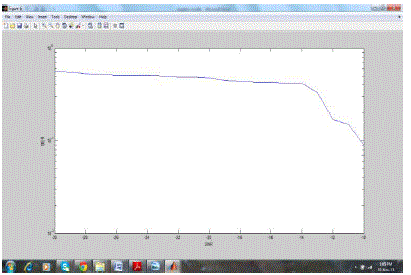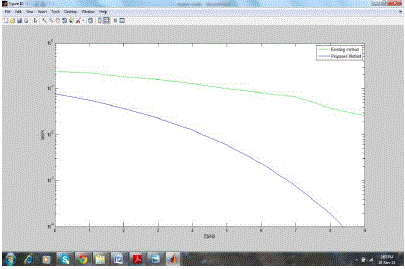ABSTRACT:Code-hopping multiple access (CHMA) isatechnique in which the spreading code changes from one code to another. CHMAsystems are proposed for anti-interception. The perfect orthogonal complementary (POC) codeshelp to improve the performance of a CHMA system. POC characterize multiple access interference (MAI)-free and multipath interference (MI)-free operation.Data is transmitted by modulating it with the Perfect Orthogonal hopping codes. In the channel noise is added and with the same hopping code demodulation is achieved and original data is recovered. CHMA system isconvenient to build the big-area networks.The bit error rate(BER) is the key component consider for performance evaluation. The BER of a complementary-coded CHMA system with channel coding has less than traditional CHMA using Walsh codes.
Keywords |
| Code-hopping multiple access, Multipath interference, multiple-access interference, Bit error rate. |
INTRODUCTION |
| Wireless communications are rapidly becoming more and more necessary for everyday activities. With so many more users
to accommodate, more efficient use of bandwidth is a priority among system operators. Equally important is the security
and reliability. One solution that has been offered is a Code Hopping Multiple Access System. It is a form of spreadspectrum,
an advanced digital wireless transmission technique. Instead of using frequencies or time slots, as do traditional
technologies, it uses mathematical codes to transmit and distinguish between multiple wireless conversations. Its bandwidth
is much wider than that required for simple point-to-point communications at the same data rate because it uses noise-like
carrier waves to spread the information.Two types of collisions normally occur in CHMA system one is constructive
collision and the other one is destructive collision Orthogonal Complementary Codes is used in CHMA system. Because
Orthogonal Complementary Code is to avoid collision between two spreaded data. |
RELATEDWORK |
| CHMA stands for "Code Hopping Multiple Access." It is a form of spread-spectrum, an advanced digital wireless
transmission technique. Instead of using frequencies or time slots, as do traditional technologies, it uses mathematical codes
to transmit and distinguish between multiple wireless conversations. Its bandwidth is much wider than that required for
simple point-to-point communications at the same data rate because it uses noise-like carrier waves to spread the
information contained in a signal of interest over a much greater bandwidth. In[1] For orthogonal downlink and statistical
In[5]multiplexing, three modes of orthogonal code hopping multiplexing (OCHM) are proposed to accommodate more
orthogonal downlink channels than orthogonal code-words for downlink channels, and they are compared. It is a low
performance method. In[2]Two important facts will be revealed by the analysis given in this paper. First, implementation of
an interference-free CDMA will never be possible unless using complementary code sets, such as the PC code sets generated
in this paper.Second, to enable the interference-free CDMA operation. It provides high complexity. In [3] the paper effort to construct
Multicarrier CDMA architecture based on orthogonal complementary codes, characterized by its unique spreading modulation scheme,
uplink and downlink signature design, and receiver implementation for multipath signal detection. In this paper number of different levels generated from the baseband could be a problem. In[4]obtain the optimal code rate in several traffic load environments by
simulation and summarize the appropriate traffic load region for each code rate as the optimal code rate. An adaptive code rate control
scheme is proposed and the base station adaptively changes the code rate according to traffic environments in order to save power, it is a
high cost method. In [5]orthogonal code hopping multiple access (OCHMA) scheme in order to improve the capacity of an uplinksynchronized
code division multiple access (CDMA) systems, it is a low performance method. |
PROPOSED SYSTEM |
| The main objective is to improve the performance of the CHMA system. By reduce the bit error rate we improve the performance of the
CHMA system.Exploiting their ideal orthogonality, we apply orthogonal complementary codes to CHMA systems. In particular, we will
show that the application of orthogonal complementary codes can significantly improve the performance of a CHMA system due to its
unique collision-resistant capability. Collision is an important disadvantage in CHMA. To avoid collision between two spreaded data, the
spreading codes should be an orthogonal complementary code. Any two complementary set of sequence are said to be orthogonal
complementary set if they are mate of each other. To deal with destructive collisions among spreading codes in CHMA systems,
convolutional coding is employed in complementary-coded CHMA systems. The bit error rate of the proposed system and traditional
CHMA system using walsh codes are analyzed. The bit error rate of the proposed system is less. |
MODULEDESCRIPTION |
| System model: In a system model for each user which is able to generate a sequence of particular hopping patterns
pertaining to a specific user based on generic complementary-coded CHMA system.
Hopping Pattern Generation: In CHMA the signature code hops from one code to another according to a specific Hopping
pattern which is generated by a Hopping pattern generator which is normally the base station. It should be unique to each
user. The Hopping pattern generation is based on Mobile Station Identifier.such as the electronic serial number.
Spreading and Modulation: Spreading modulator applied in transmitter side. Number of complementary codes and the
number of user used in spreading and modulation. The spreading code used is orthogonal complementary code works on a
flock of code rather than a single code. The purpose of communication system is to deliver a message signal from an
information source in recognizable from to auser destination, with the source and the user being physically separated from
each other. To do this the transmitter modifies the message signal into a form suitable for transmission over the channel.
This modification involves some parameter of a carrier wave accordance with the message signal. |
| Despreading: Despreading modulator applied in receiver side. The process of despreding intends to retrieve the spreaded
signal. This process uses the same spreading code as used in the transmitter. The autocorrelation function of an orthogonal
complementary code is zero for any shift except zero shift and the cross correlation for a pair of orthogonal complementary
codes is zero for all possible shifts. |
| Viterbi decoder: A viterbi decoder uses its input to compute estimates of the original multi bit sub channel data supplied to
the transmitter. The viterbi decoder follows viterbi algorithm. The viterbi algorithm is based on maximum likelihood
function.Viterbi decoder function is given byLog p(r/c) = d log (p/ (1-p)) + N log (1-p)BER Analysis: The performance of
the system is analyzed using Bit Error Rate. Proposed method for the Bit error rate is analyzed, based on with channel
coding and compared with the Walsh code CHMA method. |
RESULT |
| BER in a complementary-coded CHMA system with channel coding is much better than that in a Walsh-coded CHMA
system. Bit error rate obtained by proposed work using orthogonal sequence has less bit error rate. The proposed method is
implemented using Matlab. The bit error rate of the received signal is obtained by the sum of all the user data in the
system. So the proposed method avoid multiple access interference and multipath interference. |
| The performance of the system is analyzed using Bit Error Rate. Proposed method for the Bit error rate is analyzed, based
on with channel coding and compared with the Walsh code CHMA method. |
CONCLUSION |
| The Orthogonal Code Hopping Multiplexing with Orthogonal Complementary Codes can support more channels than the
number of orthogonal code due to the flock of codes being used. The orthogonal codes used in CHMA systems to enhance
the performance of CHMA system. Due to the ideal correlation property of the spreading code used it can mitigate the loss
due to the two most common problems in communication multiple access interference (MAI) and multipath interference
(MI). |
Figures at a glance |
 |
 |
 |
 |
| Figure 1 |
Figure 2 |
Figure 3 |
Figure 4 |
|
| |
References |
- S. Park, S. H. Moon, J. K. Kwon, and D. K. Sung, âÃâ¬ÃÅOrthogonal code hopping multiplexing for downlink statistical multiplexing,âÃâ¬Ã in Proc. IEEE7th ISSSTA, Sep. 2002, vol. 2, pp. 588âÃâ¬Ãâ592.
- H. H. Chen, S. W. Chu, N. Kuroyanagi, and A. J. Han Vinck, âÃâ¬ÃÅAn algebraic approach to generate super-set of perfect complementary codes for interference-free CDMA,âÃâ¬Ã Wireless Commun. Mobile Comput., vol. 7, no. 5, pp. 605âÃâ¬Ãâ622, Jun. 2007.
- H. H. Chen, J. F. Yeh, and N. Suehiro, âÃâ¬ÃÅA multicarrier CDMA architecture based on orthogonal complementary codes for new generations ofwideband wireless communications,âÃâ¬Ã IEEE Commun. Mag., vol. 39, no. 10, pp. 126âÃâ¬Ãâ135, Oct. 2001.
- J. K. Kwon, S. Park, D. K. Sung, and H. Lee, âÃâ¬ÃÅAdaptive code rate for orthogonal code hopping multiplexing (OCHM) in synchronous downlink,âÃâ¬Ã in Proc. IEEE WCNC, 2003, vol. 2, pp. 855âÃâ¬Ãâ859.
- B. C. Jung, S. S. Cho, and D. K. Sung, âÃâ¬ÃÅUplink capacity improvement through orthogonal code hopping in uplink-synchronized CDMA systems,âÃâ¬Ã IEEE Trans. Wireless Commun., vol. 8, no. 11, pp. 5404âÃâ¬Ãâ5410, Nov. 2009.
|